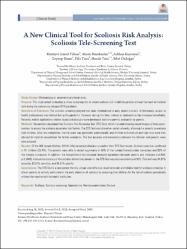| dc.contributor.author | Yılmaz, Hürriyet Gürsel | |
| dc.contributor.author | Büyükaslan, Ahsen | |
| dc.contributor.author | Kuşvuran, Aslıhan | |
| dc.contributor.author | Turan, Zeynep | |
| dc.contributor.author | Tuna, Filiz | |
| dc.contributor.author | Tunç, Hande | |
| dc.contributor.author | Özdoğan, Sibel | |
| dc.date.accessioned | 2023-10-02T13:15:05Z | |
| dc.date.available | 2023-10-02T13:15:05Z | |
| dc.date.issued | 2023 | en_US |
| dc.identifier.citation | Yılmaz, H. G., Büyükaslan, A., Kuşvuran, A., Turan, Z., Tuna, F., Tunç, H. ... Özdoğan, S. (2023). A new clinical tool for scoliosis risk analysis: Scoliosis tele-screening test. Asian Spine Journal, 17(4), 656-665. https://doi.org/10.31616/asj.2022.0299 | en_US |
| dc.identifier.issn | 1976-1902 | |
| dc.identifier.uri | https://doi.org/10.31616/asj.2022.0299 | |
| dc.identifier.uri | https://hdl.handle.net/20.500.12511/11514 | |
| dc.description.abstract | Study Design: Methodological, observational clinical study. Purpose: This study aimed to develop a virtual screening test to detect scoliosis risk initially by parents without the need for medical visit during the coronavirus disease 2019 pandemic. Overview of Literature: The scoliosis screening program has been implemented to early detect scoliosis. Unfortunately, access to health professionals was limited during the pandemic. However, during this time, interest in telemedicine has increased remarkably. Recently, mobile applications related to postural analysis were developed, but none permits evaluation by parents. Methods: Researchers developed the Scoliosis Tele-Screening Test (STS-Test), which included drawing-based images of body asymmetries, to assess the scoliosis-associated risk factors. The STS-Test was shared on social networks, allowing the parents to evaluate their children. After test completion, the risk score was generated automatically, and children with medium and high risks were then advised for medical consultation for further evaluation. The test accuracy and consistency between the clinician and parents were also analyzed. Results: Of the 865 tested children, 358 (41.4%) consulted clinicians to confirm their STS-Test results. Scoliosis was then confirmed in 91 children (25.4%). The parents were able to detect asymmetry in 50% of the lumbar/thoracolumbar curvatures and 82% of the thoracic curvatures. In addition, the forward bend test revealed favorable agreement between parents and clinicians (r =0.809, p [removed] | en_US |
| dc.language.iso | eng | en_US |
| dc.publisher | Korean Society of Spine Surgery | en_US |
| dc.rights | info:eu-repo/semantics/openAccess | en_US |
| dc.rights | Attribution-NonCommercial 4.0 International | * |
| dc.rights.uri | https://creativecommons.org/licenses/by-nc/4.0/ | * |
| dc.subject | Posture | en_US |
| dc.subject | Remote Examination | en_US |
| dc.subject | Scoliosis | en_US |
| dc.subject | Scoliosis Screening | en_US |
| dc.subject | Telemedicine | en_US |
| dc.title | A new clinical tool for scoliosis risk analysis: Scoliosis tele-screening test | en_US |
| dc.type | article | en_US |
| dc.relation.ispartof | Asian Spine Journal | en_US |
| dc.department | İstanbul Medipol Üniversitesi, Sağlık Bilimleri Enstitüsü, Fizyoterapi ve Rehabilitasyon Ana Bilim Dalı | en_US |
| dc.authorid | 0000-0002-5274-0540 | en_US |
| dc.authorid | 0000-0002-8428-3081 | en_US |
| dc.identifier.volume | 17 | en_US |
| dc.identifier.issue | 4 | en_US |
| dc.identifier.startpage | 656 | en_US |
| dc.identifier.endpage | 665 | en_US |
| dc.relation.publicationcategory | Makale - Uluslararası Hakemli Dergi - Kurum Öğretim Elemanı | en_US |
| dc.identifier.doi | 10.31616/asj.2022.0299 | en_US |
| dc.institutionauthor | Büyükaslan, Ahsen | |
| dc.institutionauthor | Tunç, Hande | |
| dc.identifier.wos | 001092006800001 | en_US |
| dc.identifier.scopus | 2-s2.0-85171632273 | en_US |
| dc.identifier.pmid | 37226382 | en_US |
| dc.identifier.scopusquality | Q1 | en_US |



















